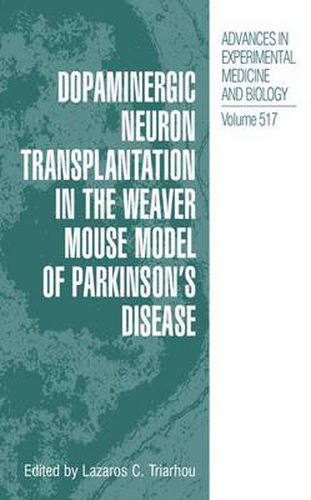Readings Newsletter
Become a Readings Member to make your shopping experience even easier.
Sign in or sign up for free!
You’re not far away from qualifying for FREE standard shipping within Australia
You’ve qualified for FREE standard shipping within Australia
The cart is loading…






This title is printed to order. This book may have been self-published. If so, we cannot guarantee the quality of the content. In the main most books will have gone through the editing process however some may not. We therefore suggest that you be aware of this before ordering this book. If in doubt check either the author or publisher’s details as we are unable to accept any returns unless they are faulty. Please contact us if you have any questions.
Parkinson’s disease, a degenerative brain disorder, affects an estimated 0.25-0.50% of the population. Symptoms result from neuronal degeneration in the nigrostriatal dopaminergic pathway and include tremor, rigidity and gradual slow- ness of spontaneous movement. The cause of Parkinson’s disease is only partially understood; both environmental factors and a genetic predisposition have been im- plicated in its etiopathogenesis. Neural transplantation is being used experimentally for providing an alternative biological source of dopamine both in animal studies and in experimental clinical trials. This book is the result of 15 years of research on the transplantation of dopaminergic neurons in the striatum of the weaver mouse, a neurological mutant characterized by genetically-determined degeneration of midbrain dopamine neurons. The weaver mouse constitutes the only available laboratory model with a chronic progressive disease that mimics Parkinsonism. The other two models currently used to investigate dopaminergic mechanisms rely on the use of the neurotoxins- hydroxydopamine and methylphenyltetrahydropyridine for the selective removal of dopaminergic neurons from an otherwise healthy organism. Structural and functional aspects of transplantation of mesencephalic dopamin- ergic grafts into the striatum of weaver mice are reviewed, including histochemical correlates of graft survival and integration, numerical aspects of donor neuron survival, ultrastructural findings on synaptogenesis, neurochemical indices of dopam- ine uptake function and receptor binding, gene expression of several structural and neurotransmitter-receptor related molecules, the levels of striatal amino acid receptors, and the behavioral effects of unilateral and bilateral neuronal transplantations.
$9.00 standard shipping within Australia
FREE standard shipping within Australia for orders over $100.00
Express & International shipping calculated at checkout
This title is printed to order. This book may have been self-published. If so, we cannot guarantee the quality of the content. In the main most books will have gone through the editing process however some may not. We therefore suggest that you be aware of this before ordering this book. If in doubt check either the author or publisher’s details as we are unable to accept any returns unless they are faulty. Please contact us if you have any questions.
Parkinson’s disease, a degenerative brain disorder, affects an estimated 0.25-0.50% of the population. Symptoms result from neuronal degeneration in the nigrostriatal dopaminergic pathway and include tremor, rigidity and gradual slow- ness of spontaneous movement. The cause of Parkinson’s disease is only partially understood; both environmental factors and a genetic predisposition have been im- plicated in its etiopathogenesis. Neural transplantation is being used experimentally for providing an alternative biological source of dopamine both in animal studies and in experimental clinical trials. This book is the result of 15 years of research on the transplantation of dopaminergic neurons in the striatum of the weaver mouse, a neurological mutant characterized by genetically-determined degeneration of midbrain dopamine neurons. The weaver mouse constitutes the only available laboratory model with a chronic progressive disease that mimics Parkinsonism. The other two models currently used to investigate dopaminergic mechanisms rely on the use of the neurotoxins- hydroxydopamine and methylphenyltetrahydropyridine for the selective removal of dopaminergic neurons from an otherwise healthy organism. Structural and functional aspects of transplantation of mesencephalic dopamin- ergic grafts into the striatum of weaver mice are reviewed, including histochemical correlates of graft survival and integration, numerical aspects of donor neuron survival, ultrastructural findings on synaptogenesis, neurochemical indices of dopam- ine uptake function and receptor binding, gene expression of several structural and neurotransmitter-receptor related molecules, the levels of striatal amino acid receptors, and the behavioral effects of unilateral and bilateral neuronal transplantations.